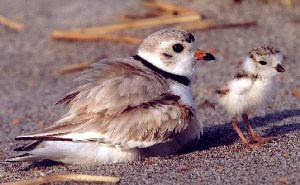Kingdom: Animalia Phylum: Chordata Class: Aves Order: Charadriiformes Family: Charadriidae Genus: Charadrius Species: C. melodus
The Piping Plover (Charadrius melodus) is a small, light colored shorebird found along the Atlantic and Gulf coasts, and inland in the northern Great Plains. Piping Plovers are found along sandy beaches and alkali flats. These small, timid birds can be hard to spot, as they easily blend into the sand. (http://www.allaboutbirds.org/guide/piping_plover/id) The Piper Plover is listed as "threatened" by the Endangered Species Act. Audubon NY's Long Island Bird Conservation has programs in place that monitor and protect nesting grounds, recruit volunteers, and find solutions for predators and other threats (http://ny.audubon.org). In July, I went on a birdwatching trip in Breezy Point in search of nesting Piping Plovers. I was lucky enough to see two adults and one chick.
Description:
- Weighs 1.5 to 2.25 ounces
- Up to 5.5 inches long
- Males and females are similar in size and plumage
- The adult has yellow-orange legs, a small orange beak with a black tip, and a black band across the forehead from eye-to-eye.
- During breeding season, a more pronounced black ring is visible around the neck.
- Nests are on the ground, within sandy areas.
- Plovers sprint along the sand, stopping and starting as they look for food.
- They have a distinctive bird call, a "melodious, organ-like, two to four tone whistle" (http://www.dec.ny.gov/)
Habitat, Migration, & Breeding:
- Piping Plovers spend their winters in warmer places from Texas to North Carolina, the Bahamas and Greater Antilles. They migrate to the North during each Spring and nest on sandy beaches.
- Food consists of worms, crustaceans, and insects. Much of their food source is found in tidal wrack, dunes, and along the shore.
- Their nests consist of scrapes that are made during courtship. The male flies over the female and swoops down to grab her attention. The male then selects the nest site and they begin the nesting process. During the breeding season, Piping Plovers are monogamous.
- Females usually lay four eggs, which hatch after 25 days. The chicks fledge after about 3 to 4 weeks.
Threats & Predators:
- Beach population, urban development along the coastline, and the destruction of natural sand dunes has been a significant cause of decline among the plovers.
- During the 19th & 20th centuries, plover feathers were used for women's hats in upper class societies. This led to the initial decline of the plover and other rare birds.
- Their nests and eggs camouflage into the sand, which helps protect them against most animal predators. However, this technique doesn't work so well with off-road vehicles and beachgoers who may unknowingly squash the nests and eggs.
- As the eggs hatch and people flock to the beach, more danger ensues for the birds. "When these painfully shy birds see people or gulls on the beach, they protectively coral their chicks back to the dune--sometimes causing the protein-needy youngsters to starve while they are in hiding" (WNY, Ch.4).
- If a predator nears the chicks, the adult plover will feign a broken wing to draw attention to itself and away from the chick.
- In addition, domestic dogs, cats, foxes, skunks, herring gulls, raccoons, opposums, and stormtides are all major threats to nesting plovers.
- "The piping plover became a protected species under the Endangered Species Act on January 10, 1986. Along the Atlantic Coast it is designated as threatened, which means that the population would continue to decline if not protected. The Endangered Species Act provides penalties for taking, harassing or harming the piping plover and affords some protection to its habitat". (http://www.fws.gov/northeast/pipingplover/overview.html)
 |
| Protective caging for plover nests. Photo taken by me @ Breezy Point |
 |
| Tidalwrack where plovers find food. Photo taken by me @ Breezy Point |
 |
| Juvenile plover. Photo taken by me @ Breezy Point |
 |
| Looking for piping plovers @ Breezy Point. Photo taken by me. |
 |
| Information sign about Piping Plovers @ Breezy Point. Photo taken by me. |

















No comments:
Post a Comment